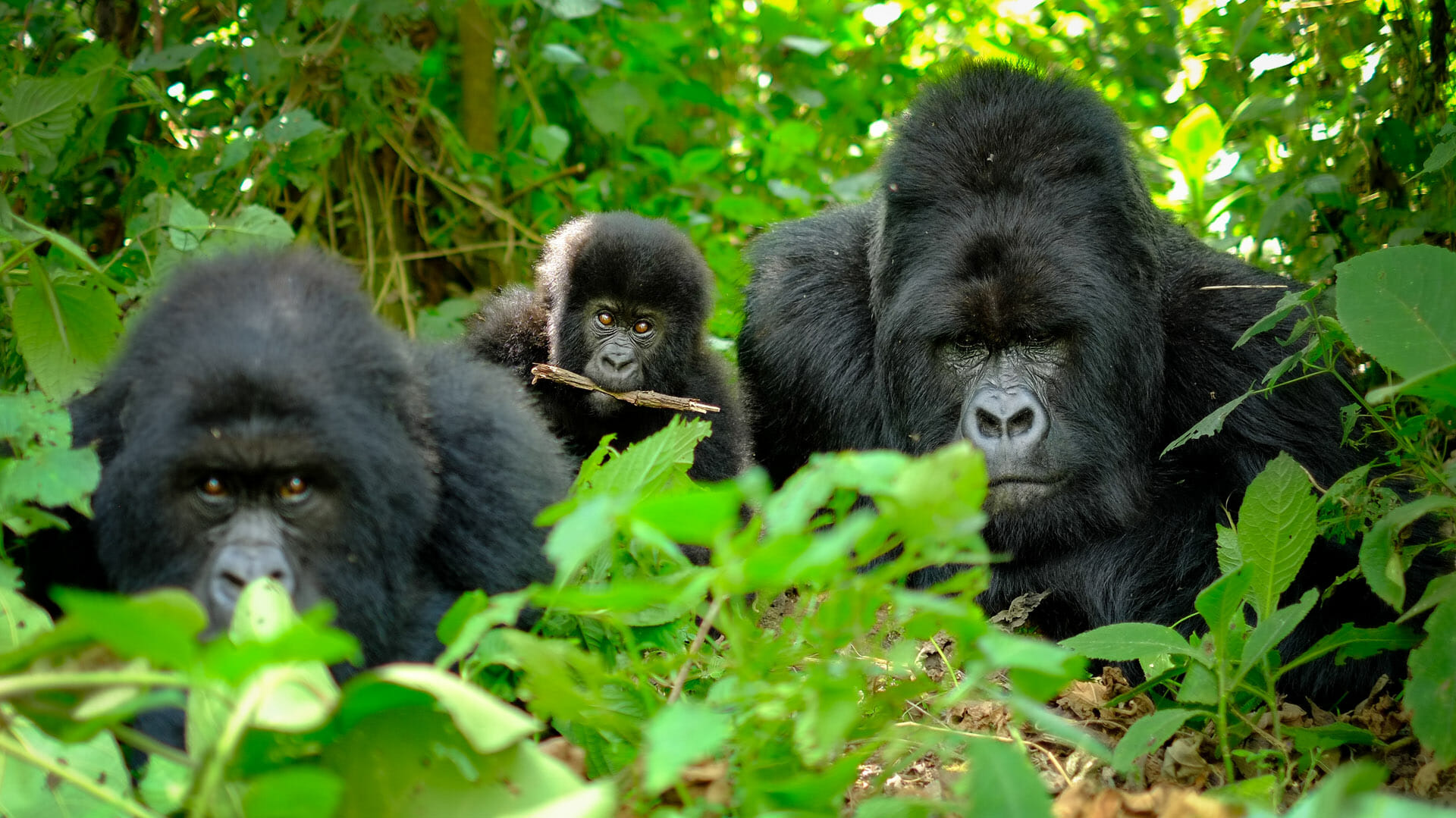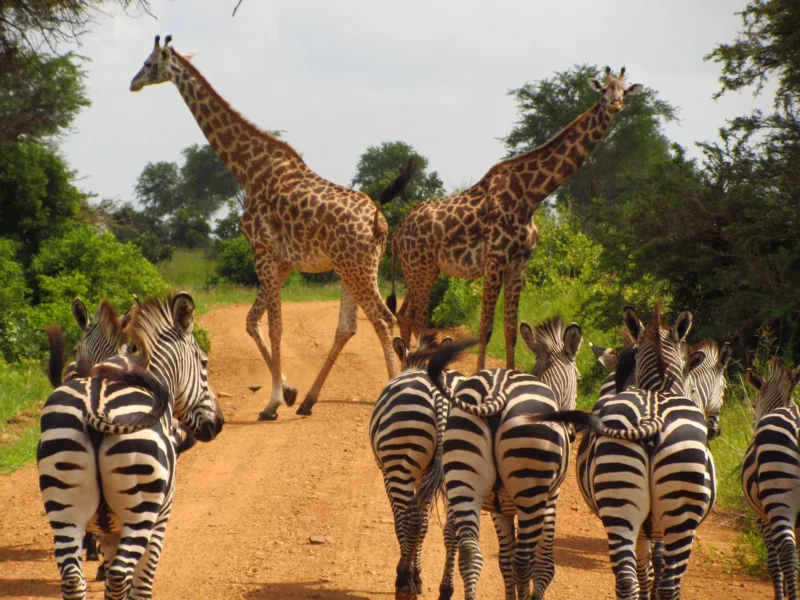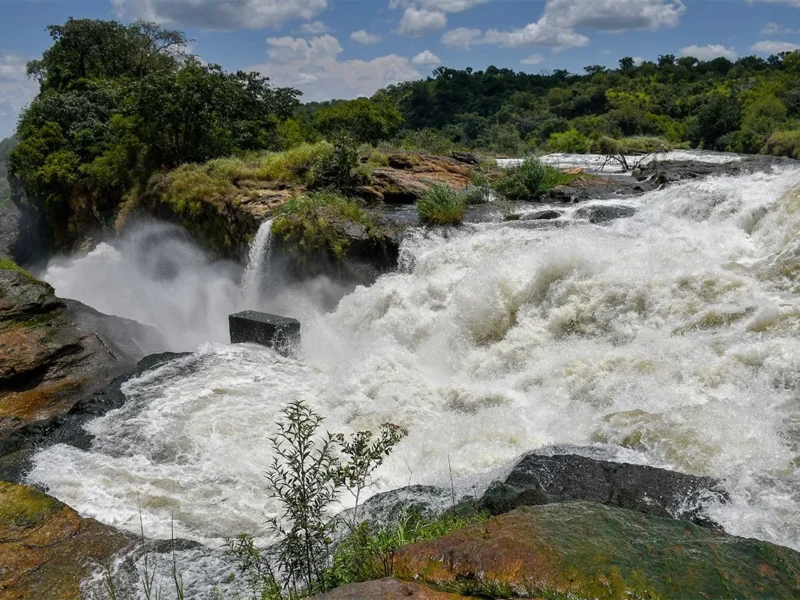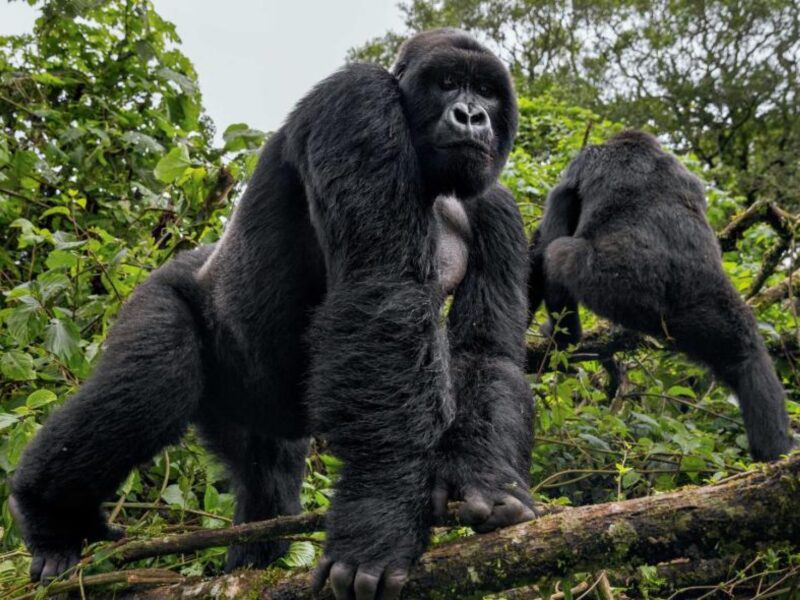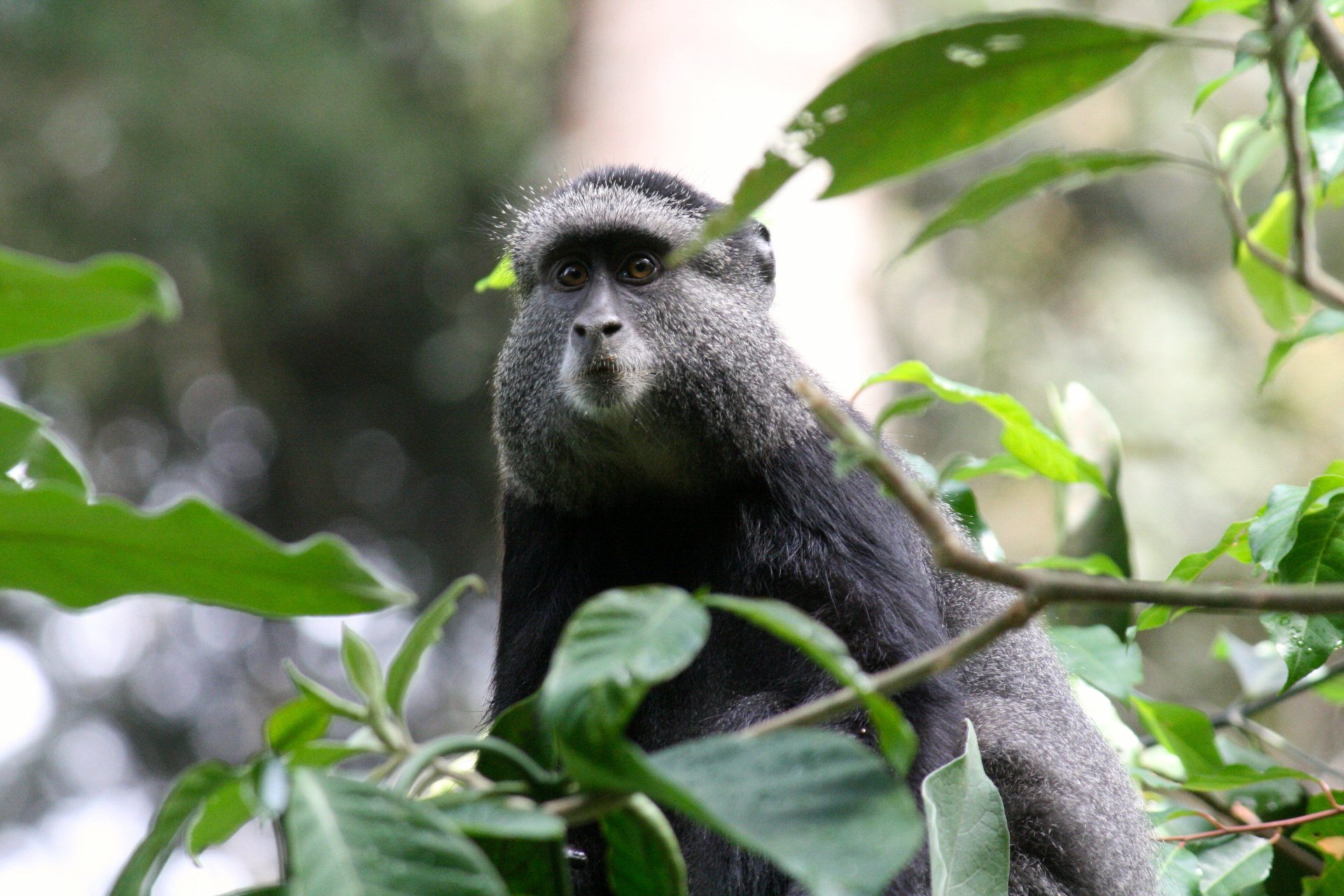
The Ugandan Blue Monkey
April 11, 2025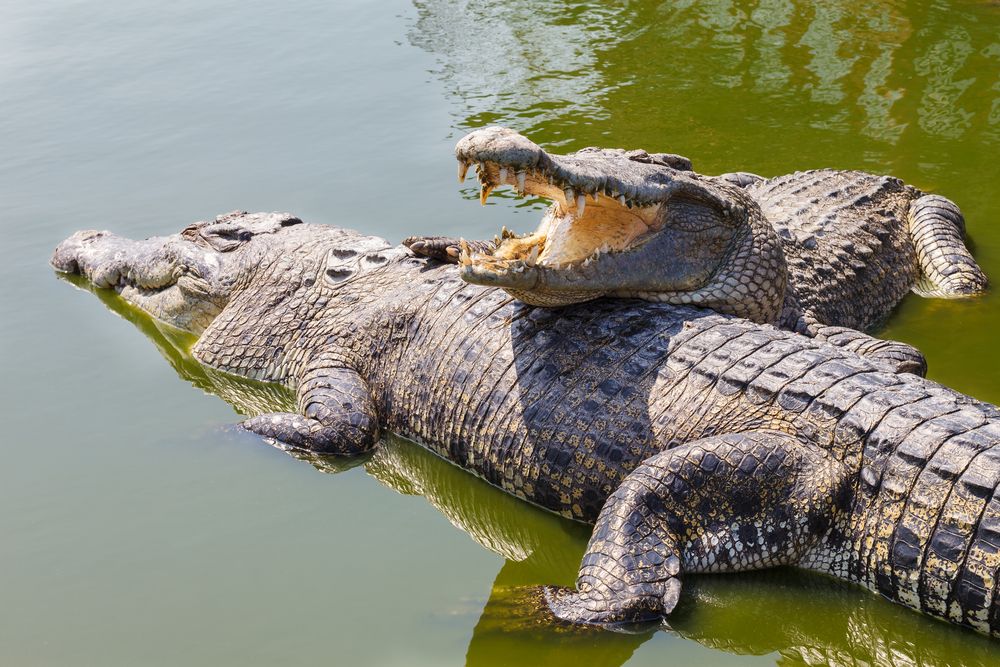
Crocodiles In Kenya
April 14, 2025Mountain Gorillas in Rwanda
Rwanda, often referred to as the “Land of a Thousand Hills,” is home to some of the last remaining mountain gorillas in the world. These majestic primates, which are critically endangered, inhabit the dense, mist-covered forests of the Virunga Mountains, located in the northwest of the country. Rwanda has become one of the premier destinations for gorilla trekking, offering an unparalleled opportunity to see these remarkable creatures up close in their natural habitat.
Where to See Mountain Gorillas in Rwanda
The primary location for gorilla trekking in Rwanda is Volcanoes National Park, which is part of the larger Virunga Mountains, a range shared by Rwanda, Uganda, and the Democratic Republic of Congo. Volcanoes National Park is famous for its stunning landscapes and its role in the conservation of mountain gorillas.
– Volcanoes National Park: This park, covering about 160 square kilometers, is home to around half of the world’s mountain gorilla population. It offers a range of trekking experiences and is renowned for its excellent gorilla-viewing opportunities. The park is accessible from the town of Kigali, Rwanda’s capital, making it relatively easy to reach for international travelers.
The Gorilla Trekking Experience
Gorilla trekking in Rwanda is one of the most memorable wildlife experiences you can have. Here’s what you can expect during your trek:
– Permits: To trek the mountain gorillas in Rwanda, you need to purchase a trekking permit. Rwanda is known for its high-quality, sustainable tourism practices, and these permits help fund the protection of the gorillas and the park. The current cost of a gorilla trekking permit in Rwanda is $1,500 per person. This high fee contributes to conservation efforts and local community development.
– Trekking: Gorilla trekking in Rwanda typically involves hiking through dense forest and rugged terrain to locate the gorillas. The trek can range from an easy walk to a more strenuous hike, depending on the location of the gorillas. The trek generally lasts between 1 and 5 hours, though it may take longer if the gorillas are further away.
– Guides and Rangers: Each trek is led by an experienced guide and park rangers who are familiar with the gorillas’ habits and the park’s ecosystem. These experts ensure your safety and provide interesting insights into the behavior and ecology of the gorillas.
– Spending Time with the Gorillas: Once you locate a gorilla family, you are allowed to spend an hour with them. During this time, you can observe their behavior, watch them eat, play, or interact with each other. The experience is incredibly moving as you come face-to-face with these endangered creatures. Visitors are encouraged to remain quiet, move slowly, and avoid sudden movements to avoid disturbing the gorillas.
– Physical Demands: Trekking through Volcanoes National Park can be physically challenging, particularly if the gorillas are located higher up the mountains. It’s recommended that visitors be in good physical condition, as the terrain can be steep and muddy.
Conservation Efforts in Rwanda
Mountain gorillas were once on the brink of extinction due to habitat loss, poaching, and diseases transmitted by humans. However, Rwanda has made significant strides in protecting and conserving the mountain gorillas. Some of the key efforts include:
– Gorilla Monitoring and Protection: Rwanda’s government, in partnership with international organizations like the World Wildlife Fund (WWF) and Fauna & Flora International, has heavily invested in the monitoring and protection of gorilla populations. Rangers track gorilla families daily to ensure their safety, and anti-poaching measures are strictly enforced.
– Gorilla Habituation: Rwanda has implemented a gorilla habituation program that allows certain gorilla families to become accustomed to human presence. This process helps ensure that tourists can safely observe the gorillas without disturbing their natural behavior. Habituated gorilla families are gradually introduced to the presence of humans over several months or years.
– Community Involvement: The local communities around Volcanoes National Park benefit directly from gorilla tourism. Revenue from trekking permits and other park activities supports local development, including education, health care, and infrastructure. Local guides, porters, and rangers are employed, creating sustainable livelihoods for people living near the park.
– Tourism as a Conservation Tool: The high cost of trekking permits in Rwanda plays a crucial role in funding conservation efforts. The revenue helps to maintain the park, protect the gorillas, and invest in further research and monitoring.
Gorilla Families in Volcanoes National Park
There are several habituated gorilla families in Volcanoes National Park, each with its own distinct characteristics. Some of the most famous gorilla families include:
– Susa Group: One of the largest and most famous groups, Susa is led by the dominant silverback, Karisimbi. This group is known for being highly active and often difficult to reach due to their location at higher altitudes.
– Amahoro Group: Known for their peaceful nature, the Amahoro family is one of the most sought-after trekking groups. They are led by the silverback Ubumwe, who is known for his gentle temperament.
– Group 13: A smaller group, but equally fascinating, this family has a great deal of social interaction and is often easier to trek to than some of the others.
– Hirwa Group: A recently formed group with a dynamic leader, Ndahiro, who has taken charge of several females. Hirwa is an exciting group for trekkers, with a unique family dynamic.
Other Attractions in Rwanda
While gorilla trekking is the highlight of any visit to Rwanda, the country offers a variety of other attractions:
– Golden Monkey Trekking: In addition to gorillas, Volcanoes National Park is also home to golden monkeys, an endangered species. Trekking to see these vibrant primates is another popular activity.
– Kigali: Rwanda’s capital, Kigali, offers rich cultural experiences, such as the Kigali Genocide Memorial, which commemorates the tragic 1994 genocide.
– Lake Kivu: A beautiful lake located in western Rwanda, perfect for relaxing, boat rides, and water sports.
Rwanda’s mountain gorillas are a living testament to the country’s remarkable conservation efforts. The opportunity to trek through the stunning landscapes of Volcanoes National Park and come face-to-face with these gentle giants is a once-in-a-lifetime experience. Rwanda has become a global leader in the protection and conservation of mountain gorillas, and by visiting, travelers contribute to their ongoing survival.
Why Rwanda is the Best Place for Gorilla Trekking
Rwanda has become one of the most sought-after destinations for mountain gorilla trekking, and it’s no surprise why. The country has invested heavily in preserving its wildlife, and its conservation efforts have led to a significant increase in the population of mountain gorillas. Today, Rwanda is home to some of the most accessible and safe gorilla trekking experiences in Africa.
1. Rwanda’s Commitment to Conservation
Rwanda’s success in mountain gorilla conservation is a result of long-term commitment and effective management strategies. The government has worked closely with local communities, conservationists, and international partners to ensure the protection of the gorillas and their habitat. This collaboration has contributed to the steady increase in the gorilla population.
The mountain gorilla population has been slowly but surely rising over the years, with Gorilla numbers increasing from fewer than 250 in the 1980s to over 1,000 today. This recovery is due to the dedicated conservation efforts that have included anti-poaching patrols, habitat restoration, and community-based conservation programs.
2. Safe and Eco-friendly Gorilla Trekking
Rwanda’s gorilla trekking is not only rewarding but also eco-friendly and sustainable. A significant portion of the revenue generated from trekking permits goes directly into funding conservation initiatives and local community development. Additionally, Rwanda limits the number of trekking permits issued each day to protect the gorillas from human-related stress and to maintain the natural balance of the ecosystem.
Best Time to Go Gorilla Trekking in Rwanda
The best time to trek gorillas in Rwanda is during the dry seasons:
– Mid-December to February: These months are the peak of the dry season and offer the most pleasant trekking conditions.
– June to September: Another dry period when trekking is easier, as the forest trails are less muddy, and the chances of clear skies are higher.
That said, gorilla trekking in Rwanda is possible year-round. While the rainy seasons (March-May and October-November) may lead to muddier trails and more challenging conditions, the rain also makes the forests incredibly lush and beautiful. Plus, fewer visitors during the rainy season can lead to a quieter, more intimate experience with the gorillas.
What to Expect on a Gorilla Trek
1. The Trekking Journey
– Distance: The distance of your trek will depend on where the gorillas are located. It could be as short as 1-2 hours or as long as 6-8 hours, depending on the altitude and where the gorilla family is currently residing.
– Terrain: Rwanda’s Volcanoes National Park is known for its steep, mountainous terrain, which can be physically demanding. The forest trails are often muddy and slippery, and trekkers should be prepared for a bit of a challenge. Hiking boots and waterproof clothing are essential.
– Guides: The trek is led by trained guides and park rangers, who are experienced in tracking the gorillas. They will ensure your safety, provide interesting information about the gorillas, and help with any logistical needs during the trek.
2. Interaction with Gorillas
– Gorilla Behavior: Mountain gorillas are generally peaceful and calm creatures. You’ll get to observe their interactions within the group, including feeding, grooming, and socializing. Gorillas are very similar to humans in many ways, so it’s fascinating to watch how they behave—especially the silverbacks, who are the dominant males, and the playful young gorillas.
– One Hour with the Gorillas: Once you reach the gorilla family, you will be allowed one hour of viewing. It may seem short, but it’s an incredibly precious and intimate experience. During this hour, you can take photos (without using flash) and observe their natural behaviors. It’s a powerful experience to be so close to such rare and intelligent creatures.
Gorilla Families in Volcanoes National Park
Rwanda’s Volcanoes National Park is home to 12 habituated gorilla families that are open for trekking. These families include both adult silverbacks and their females and offspring, and each family has its own unique dynamics and personality.
Some of the well-known families include:
– Susa Group: The largest group with 28 members, the Susa family is one of the most famous. It is led by a silverback named Karisimbi. Due to the altitude of their location, trekking to see the Susa family can be challenging, but it’s worth it for those looking for an adventure and an incredible experience.
– Amahoro Group: A peaceful family led by a silverback named Ubumwe, the Amahoro group is known for its gentle nature. This group is often considered one of the easiest to track.
– Hirwa Group: A dynamic and youthful group, Hirwa’s leader Ndahiro is well known for his leadership style. This family has a fascinating social structure, which makes it a popular choice for trekkers.
Other Wildlife in Volcanoes National Park
Although gorillas are the main attraction, Volcanoes National Park also offers opportunities to see other wildlife, including:
– Golden Monkeys: Another endangered species, golden monkeys are unique to the Virunga region and can also be trekked. Golden monkey trekking is less physically demanding than gorilla trekking, but it still offers a great opportunity to encounter another fascinating primate species.
– Birdwatching: Volcanoes National Park is a paradise for bird enthusiasts. With over 200 species of birds, including the Rwenzori turaco, the park offers fantastic birdwatching opportunities.
– Other Wildlife: While not as prominent as the gorillas, the park is home to a variety of forest species like bushbucks, buffaloes, and forest elephants.
How to Prepare for Gorilla Trekking in Rwanda
Here are some important tips to ensure a smooth and enjoyable trekking experience:
– Physical Fitness: Gorilla trekking can be strenuous, so it’s important to be in good physical shape. If you are not used to hiking, consider preparing by doing some cardio or hiking beforehand.
– What to Wear:
– Wear sturdy hiking boots with good grip for muddy or slippery trails.
– Bring a light rain jacket or waterproof clothing in case it rains.
– Long sleeves and pants to protect against thorns, insects, and the cold.
– A hat and sunglasses to protect against the sun.
-What to Bring:
– A small backpack with water, snacks, and a camera (without flash).
– A walking stick, which is provided by the park, can help with balance during the hike.
– Physical Challenges: If you have mobility issues or find it difficult to trek long distances, it’s best to consult with the tour operator ahead of time, as there are a limited number of porters who can assist with the hike.
Gorilla trekking in Rwanda is a once-in-a-lifetime experience that offers a rare and intimate glimpse into the lives of mountain gorillas, some of the world’s most endangered creatures. It’s an experience that leaves a lasting impact on visitors, offering a deeper understanding of wildlife conservation and the beauty of Africa’s natural landscapes.
With Rwanda’s ongoing conservation efforts, trekking permits are helping to ensure the long-term survival of these incredible animals while providing economic benefits to the local communities. If you’re looking for a wildlife experience that is both thrilling and meaningful, gorilla trekking in Rwanda is truly a bucket-list adventure!

